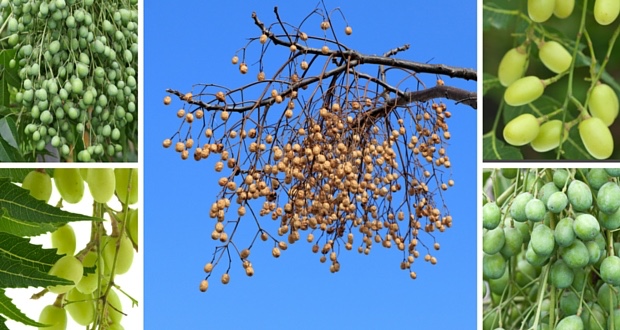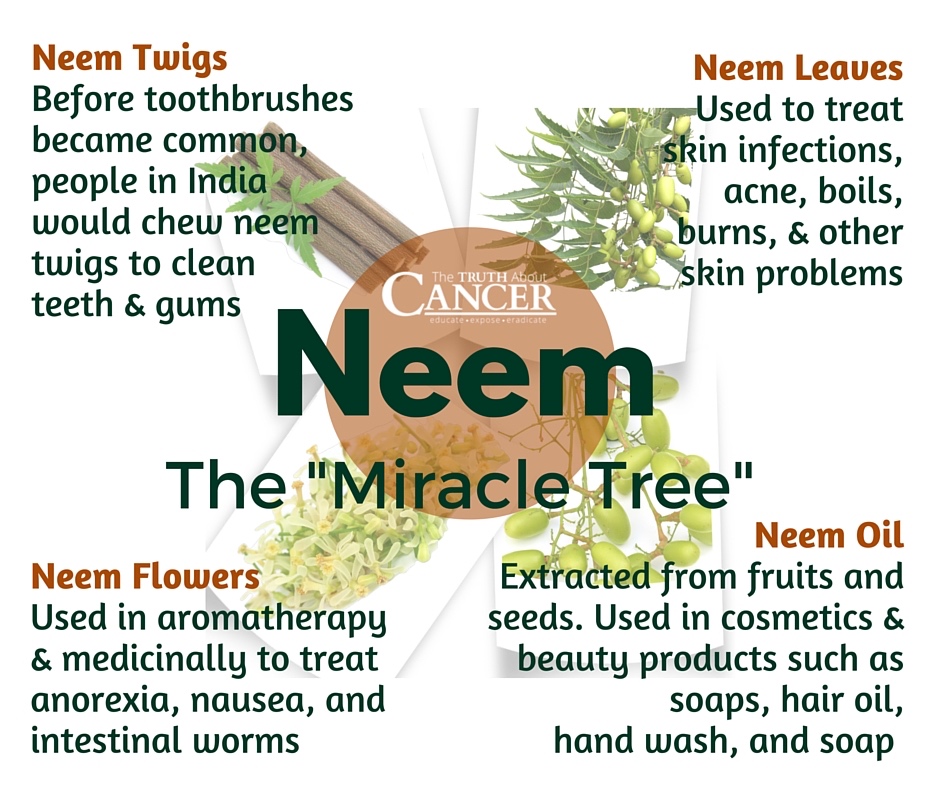By Suresh Nair

Many North Americans have never heard of it, but could an evergreen tree from India offer powerful health benefits… including the ability to fight cancer? The Neem Tree – whose biological name is Azadirachta indica (also known as Indian Lilac) – is an evergreen tree that belongs to the mahogany family. While neem is often used to make furniture, this tree also offers powerful anti-cancer and healing benefits.
Neem grows freely in the tropical and semi-tropical regions of India and the Indian subcontinent,
including Nepal, Pakistan, Bangladesh, and Sri Lanka. A. indica can also be found growing in Africa, the Americas, Australia, and the South Pacific islands. Its fruits and seeds are the source of medicinal neem oil.
In the ancient Indian language Sanskrit, the neem tree is called “Aristha” or “reliever of sicknesses.” In the Vedas (a large body of texts originating in ancient India, which make up the oldest known scriptures of Hinduism), neem is known as “Sarva Roga Nivarini” meaning “One that cures all ailments and ills.”
Neem is referred to as the “Miracle Tree” and because of its tremendous medical properties, the neem tree is also considered to be a “village pharmacy” in India. Extracts of neem leaves, twigs, bark, seeds, and flowers are integral components of many traditional remedies in the Indian medical system of Ayurveda. These remedies date back, by some accounts, nearly 5,000 years.
More than 60 different biologically active neem tree compounds have been identified and used for a wide variety of health and medical applications. Some of these include nimbin, nimbolide, azadirachtin A, nimbidiol, quercetin, and nimbidin.
The Many Uses of Neem
According to Ayurveda, the neem tree offers numerous health benefits. Let’s take a look at the specific uses and health benefits offered by various parts of the neem tree.
Neem Leaves
Neem leaves are reputed to possess antibacterial, antiviral, anti-fungal, and anti-malarial properties – which is why their extracts are used to treat skin infections, acne, boils, burns, and many other skin problems.Some traditional uses for neem leaves include:
- Skin cleanser – Neem stops the growth of the acne-causing bacteria P. acnes, along with suppressing P. acnes-induced inflammation.
- Wound healer – a paste of neem leaves is applied on wounds, skin eruptions, and insect bites. When combined with turmeric, this paste is also used to treat skin itching, eczema, ring worm, and other mild skin diseases.
- Hair conditioner – Neem leaf extracts and paste are used to condition the hair and scalp and are believed to strengthen hair and promote hair growth.
- Anti-dandruff agent – water in which neem leaves have been boiled is applied to hair after regular shampooing to rid the scalp of dandruff.
- Eye cleansing and soothing – extract of neem leaves in water is used to wash the eyes and is said to offer relief from irritation, tiredness, and redness.
- Immune booster – consuming extracts of neem leaves and bark (again, made by boiling in water) are believed to increase overall immunity. These extracts also reputedly lower blood sugar levels and heal ulcers.
Neem Flowers
Unlike the rest of the neem tree which is bitter, the white and delicate neem flowers possess a sweet, almost jasmine-like scent. They are used fresh, dried, or in a powdered form as food and as garnish in some Indian cooking traditions.
Neem flowers are used medicinally to treat anorexia, nausea, and intestinal worms. They are also used in aromatherapy because of their calming effect.
Neem Twigs
Before toothbrushes became common, people in India would traditionally chew away at neem twigs in the morning. In Indian villages, many people still do this.
This habit helps to fight germs, maintain alkaline levels in saliva, keep bacteria away, heal swollen gums, and leads to whiter teeth. Finally, the twig also shreds into bristle-like threads that help to remove and prevent plaque.
Neem Oil
Neem oil – extracted from fruits and seeds of the neem tree – is rich in antioxidants and fatty acids. This makes it an ideal ingredient in cosmetics and beauty products such as soaps, hair oil, hand wash, and soap.
Traditional uses of Neem oil include:
- Skin cleanser – 2-3 drops of neem oil diluted with water and applied on the skin helps to keep the skin clear, removing acne, blackheads, and helping to heal skin diseases.
- Skin toner and mosquito repellent – Neem oil contains high levels of vitamin E and is very nourishing for the skin, helping to maintain a balanced tone. When added to face packs, it helps to tone aging skin and relieves irritation and itching. It is also an excellent mosquito repellent.
- Natural shampoo – Rubbing neem oil into the scalp can strengthen hair, prevent hair fall, and remove dandruff.
The Anti-Cancer Benefits of Neem
Excitingly, naturally-occurring bioactive compounds obtained from various parts of the neem tree have been shown to induce “apoptosis” or programmed cell death in different types of tumor cells in laboratory conditions. Some of these compounds stimulate the immune system to fight cancer cells better. Neem compounds may also prevent cancer development by generating high levels of antioxidants and carcinogen-detoxifying enzymes.
Overall, neem compounds show impressive anti-cancer potential against many human cancer cell lines and animal models for human cancers. Among these are colon, stomach, pancreas, lung, liver, skin, oral, prostate, and breast cancers.
Anti-Carcinogenic and Anti-Mutagenic Effects of Neem
Over the last two decades, cancer researchers have convincingly shown that cancer formation as a result of exposure to certain specific mutagens and pro-carcinogens can be prevented by neem extracts.
As a result, these extracts and bioactive neem compounds may one day play a key role in the future development of chemopreventive anti-cancer agents.
Neem Stops Cancer Cell Growth and Migration
Researchers in India, Europe, and Japan have shown that bioactive compounds present in neem bark, leaves, and seed oil could be used to treat a wide variety of cancers.
For instance, a recently published study showed that nimbolide – a bioactive neem compound – was able to induce apoptosis in pancreatic cancer cells, to the extent that the size and number of cancer cell colonies was reduced by 80%.
Apoptosis or programmed cell death is a genetically driven process that happens naturally all the time in the body. It’s a safe way to get rid of diseased and dying cells without affecting nearby healthy cells and tissues.
Anti-cancer practitioners are also trying to eliminate cancer cells by inducing apoptosis selectively in them, without affecting normal cells. In this regard, neem is an excellent choice as neem extracts as well as purified neem compounds have been shown to cause apoptosis in cancer cells.
Nimbolide also reduced the ability of pancreatic cancer cells to migrate and invade other areas of the body by an astonishing 70%. Migration and invasion – known scientifically as “metastasis” – of cancer cells to other areas of the body is the main reason why pancreatic and other cancers are so lethal.
Pancreatic cancer is the most lethal of all, with 94% of patients dying within the first five years of diagnosis, with no conventional treatment in sight.
One of the most promising aspects of this study was that nimbolide did not harm healthy cells. In other words, using nimbolide to treat pancreatic and perhaps other forms of cancer in the near future may not result in the toxic side effects that chemotherapy and radiation typically do.
Neem Potentiates Anti-Cancer Drugs and Protects Against Their Toxicity
Neem preparations have been shown to potentiate (enhance the effect of) the actions of anti-cancer agents. They also provide protection against the life-threatening side effects of some of these very toxic drugs.
For instance, Cisplatin and 5-fluorouracil (5-FU) are well-known anti-cancer drugs with devastating side effects, especially because they also massively kill normal blood cells. Normally, another drug known as granulocyte colony stimulating factor (GCSF) is given along with these two anti-cancer drugs to try and minimize their toxic side effects.
Interestingly, pretreatment with neem leaf preparation (NLP) has been found to protect blood cells in laboratory mice treated with Cisplatin and 5-FU. This means NLP could potentially be a safer and cheaper substitute than granulocyte colony stimulating factor. GCSF is not only expensive, but is also known to promote angiogenesis and tumor development on its own!
Neem Enhances the Actions of Detoxifying Enzymes
Extracts of neem leaves have been shown to enhance the actions of so-called “phase-II hepatic enzymes” such as Glutathione S-transferases and DT-diaphorase. Both these enzymes are known to be involved in detoxification of chemical carcinogens.
Additionally, neem leaf extracts enhance the activity of various liver antioxidant enzymes. Amongst these are glutathione reductase, glutathione peroxidase, and superoxide dismutase, which are known to help in detoxifying the body.
Neem: Bioimmunotherapy Against Cancer
Boosting the body’s own immune system to target specific health risks is known as bioimmunotherapy. Anti-cancer practitioners have begun to incorporate this strategy to fight cancer. Recent studies show that neem may exert some of its anti-cancer effects by enhancing the body’s immune response.
Recently published peer-reviewed studies carried out at the Chittaranjan National Cancer Institute in Kolkata, India, showed that a bioactive protein from leaves of the neem tree prevents cancer cells from growing in mice by doing exactly this. Instead of targeting the cancer cells directly, this protein – known as Neem Leaf Glycoprotein (NLGP) – acts on immune cells present within the tumor’s immediate surroundings, known as the “tumor microenvironment”.
Normally, immune cells attack and destroy cancer cells. However, as some tumors grow, immune cells in their microenvironment become “enslaved” by cancer cells. In a bizarre role-reversal, these immune cells now begin to promote the growth and proliferation of cancer cells in the tumor instead of fighting them.
In a dramatic twist straight out of a thriller, NLGP seemingly returns immune cells in the tumor microenvironment to a more normal state. It makes them hostile again to cancer cells and prevents them from growing any further.
A good example can be found in one group of cancer-killing immune cells known as the CD8+ or “killer” T cells. When triggered by NLGP, the number of these T cells was seen to rise significantly, helping to restrict cancer growth. What’s more, these killer T cells also showed a greater cancer cell killing capacity when compared to killer T cells that were not treated with NLGP.
A Word of Caution About Neem
Various parts of the neem tree and its extracts have been used by humans for medicinal purposes for hundreds of years.While the uses of neem seem limitless, precautions need to be taken and neem products should be used with care. Indiscriminate consumption of higher than necessary doses may sometimes cause unpleasant side effects.
Some people are allergic to neem compounds – leading to itching, swelling of the mouth and throat, wheezing, and breathing difficulties. In very rare instances, some neem compounds may also damage the liver and kidneys.
Therefore, it is always advisable not to medicate yourself with any products containing neem extracts or neem compounds. Always consult a trustworthy alternative healthcare provider first, and be sure to apply or consume these products under properly qualified supervision.
Conclusion
The neem tree has been a source of safe and powerfully effective solutions for human health problems for many hundreds of years. Over the past few decades, modern scientific researchers have purified some of the active ingredients from this ancient “reliever of sicknesses” – and they are gradually beginning to understand their healing mechanisms.
There is now compelling scientific evidence that many neem compounds possess promising anti-cancer properties. In the near future, combinations of bioactive neem compounds, either on their own or given along with anti-cancer drugs, chemotherapy, and radiotherapy seem likely to become a reliable standard treatment of choice for many cancer patients.
Live your life without the threat of cancer. Go here to be notified each week about new, cutting-edge information that impacts your health.

No hay comentarios:
Publicar un comentario